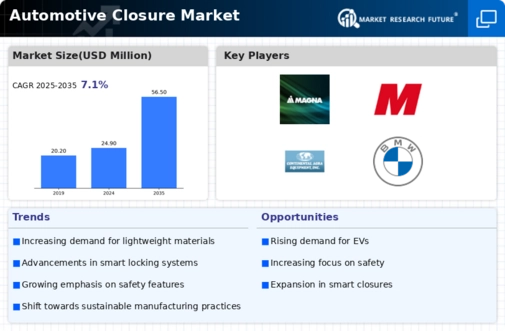Market Analysis
In-depth Analysis of Automotive Closure Market Industry Landscape
The automotive closure market, encompassing components like doors, windows, and hoods, is influenced by a myriad of market factors that collectively shape its dynamics. Firstly, consumer preferences and trends in automotive design significantly impact the market. As consumers increasingly seek vehicles with advanced safety features, aerodynamics, and aesthetic appeal, automotive closures become integral elements that manufacturers continually innovate to meet evolving expectations. Additionally, the demand for lightweight materials in vehicle construction to enhance fuel efficiency influences the materials used in automotive closures, with a growing emphasis on materials like aluminum and advanced composites.
Regulatory standards and safety requirements also play a crucial role in shaping the automotive closure market. Governments worldwide impose stringent safety and emissions standards, driving automotive manufacturers to incorporate advanced closure systems that meet or exceed these regulations. The push for energy-efficient and eco-friendly vehicles further influences the market, encouraging the integration of smart and energy-efficient closure technologies, such as power-operated windows and sensor-based safety features.
Global economic conditions and automotive industry trends contribute significantly to the market dynamics of automotive closures. Economic factors, including GDP growth, consumer spending, and automotive sales, impact the overall demand for vehicles and subsequently influence the demand for automotive closure systems. Moreover, industry trends such as the rise of electric vehicles (EVs) and autonomous driving technologies are reshaping the requirements for closures, with a focus on aerodynamics, noise reduction, and enhanced safety features.
Technological advancements are driving innovation in the automotive closure market. The integration of smart technologies, including sensors, cameras, and touch-sensitive surfaces, is becoming increasingly prevalent. Advanced driver assistance systems (ADAS) and connectivity features require sophisticated closure systems that can accommodate these technologies seamlessly. The quest for autonomous vehicles further propels the need for innovative closures that support the transition to self-driving capabilities, influencing the market towards more sophisticated and technologically advanced solutions.
Global supply chain dynamics and the availability of raw materials impact the automotive closure market. Fluctuations in raw material prices, such as steel and aluminum, can influence the overall manufacturing cost and subsequently affect product pricing within the market. Moreover, disruptions in the supply chain, as witnessed during the COVID-19 pandemic, underscore the importance of resilient and diversified supply chains for automotive closure components.
Competitive factors within the automotive industry also contribute to the market dynamics of closures. Original Equipment Manufacturers (OEMs) and suppliers continually strive to differentiate their products, driving innovation and competition. Cost efficiency, quality, and the ability to offer customized solutions are key competitive factors influencing purchasing decisions among automakers, further shaping the landscape of the automotive closure market.
Environmental sustainability is emerging as a critical factor in the automotive closure market. As the automotive industry aims to reduce its environmental impact, manufacturers are increasingly focusing on sustainable materials and manufacturing processes for closures. This includes the use of recycled materials, eco-friendly coatings, and eco-conscious production methods, aligning with broader industry efforts to promote environmental responsibility.
The aftermarket for automotive closures is another dimension influencing market dynamics. The availability of replacement closures, along with the growing trend of customization and modification in the aftermarket, contributes to the overall demand for automotive closures beyond original equipment installations. This aftermarket demand is influenced by factors like vehicle age, wear and tear, and consumer preferences for upgrading or personalizing their vehicles.
The automotive closure market is shaped by a complex interplay of factors, ranging from consumer preferences and regulatory standards to technological advancements and global economic conditions. As the automotive industry continues to evolve, manufacturers of automotive closures must navigate these multifaceted market factors to deliver solutions that meet the changing demands of the industry and consumers alike.







Leave a Comment